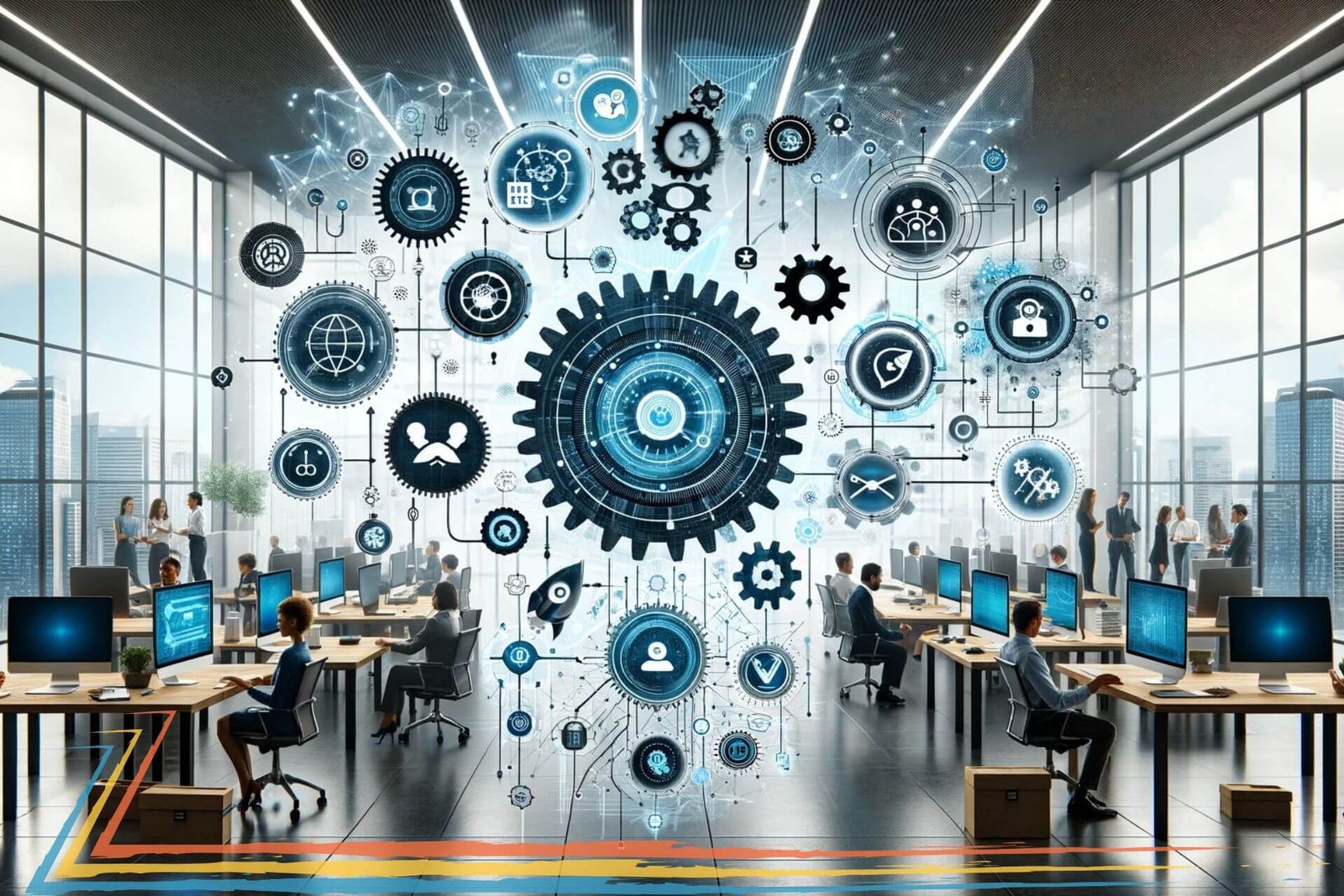The traditional hierarchical organizational structure, with its clear chains of command and multiple management layers, has long been the norm in many industries. However, a significant shift is underway towards flatter, more agile organizational models.
This transformation is driven by the need for increased innovation, responsiveness, and employee satisfaction and is enabled by advancements in technology, particularly artificial intelligence (AI). In this blog post, we will explore the current state of organizational structures, the benefits and challenges of adopting flatter and more agile models, the impact of technology on these transformations, and potential future trends in work structures.
Current State of Organizational Structures
The landscape of organizational structures is undergoing a significant transformation. Traditionally, many companies have operated with hierarchical models characterized by clear chains of command and multiple management layers. These structures have effectively maintained order and control, particularly in large corporations.
However, as the business environment becomes increasingly dynamic and complex, the limitations of hierarchical structures—such as inefficiencies, slower communication, and a lack of agility—are becoming more apparent. In response, organizations are exploring and adopting new models emphasising flexibility, collaboration, and innovation. This shift marks a critical evolution in how businesses operate and compete today.
Traditional Hierarchical Models
Hierarchical structures are characterized by a clear chain of command with multiple layers of management. Each level of the hierarchy is responsible for a specific aspect of the organization, creating a well-defined, top-down approach to decision-making. Large corporations like General Motors and traditional financial institutions have long relied on this model to maintain order and control. While hierarchical structures can provide clarity and stability, they often lead to inefficiencies, slower communication, and a lack of agility.
Overview of Organizational Structures
An organizational structure outlines how certain activities are directed to achieve the goals of an organization. These activities can include rules, roles, and responsibilities and determine how information flows between levels within the company. For instance, in a centralized structure, decisions flow from the top down, while in a decentralized structure, decision-making power is distributed among various levels of the organization.

Types of Organizational Structures
Benefits of Organizational Structures
An effective organizational structure not only defines a company’s hierarchy but also enhances efficiency, clarity, and productivity. It ensures that employees understand their roles and responsibilities, which leads to better performance and achievement of company goals. For example, in a hierarchical organization, employees know to whom they should report, reducing confusion and increasing accountability.

Benefits and Challenges of Flatter and More Agile Models
As organizations transition from traditional hierarchical structures to flatter, more agile models, they encounter a range of benefits and challenges. These modern structures are designed to enhance flexibility, foster innovation, and improve organisational communication. By breaking down silos and empowering employees, agile models can drive significant improvements in responsiveness and efficiency.
However, this shift also brings its own set of challenges, including resistance to change, implementation complexities, and potential role ambiguities. Understanding both the advantages and hurdles of these new organizational structures is crucial for leaders aiming to navigate and optimize this transformation successfully.
Benefits
- Improved Communication and Collaboration: Flatter structures break down silos, enabling faster information flow and more effective teamwork. For example, Spotify’s squad model, which organizes employees into small, cross-functional teams, has significantly improved communication and innovation.
- Increased Innovation: Agile organizations can drive greater innovation by empowering employees and fostering a culture of experimentation. Google’s 20% time policy, which allows employees to spend one day a week working on projects they are passionate about, has resulted in the development of successful products like Gmail and Google Maps.
- Greater Flexibility and Responsiveness: Agile models allow organizations to quickly adapt to market changes and evolving customer needs. This flexibility is especially valuable in dynamic industries like technology and consulting.
- Employee Satisfaction and Retention: Enhanced autonomy and engagement lead to higher job satisfaction and retention rates. A survey by Gallup found that organizations with high employee engagement have 21% higher profitability and 17% higher productivity.
Challenges
- Resistance to Change: Implementing a flatter structure can be met with resistance, particularly from management. Cultural inertia and fear of losing control are common obstacles.
- Implementation Complexities: Restructuring processes and redefining roles and responsibilities can be complex and time-consuming. Organizations must carefully plan and manage the transition to avoid disruption.
- Potential for Role Ambiguity: Without clear career progression paths, employees may experience confusion regarding their responsibilities and future opportunities. This can lead to frustration and decreased morale.

Impact of Technology on Organizational Transformations
Role of AI and Automation
AI and automation significantly transform businesses by streamlining processes and enhancing decision-making capabilities. AI-driven tools like Asana and Trello improve task coordination, while advanced autonomous systems are being integrated into various environments, from autonomous vehicles to automated grocery checkouts. In human resources, AI is revolutionizing talent acquisition and management, enabling organizations to better identify and nurture top talent. McKinsey estimates that AI could add up to $5.8 trillion in annual value across sectors, highlighting its potential to drive substantial economic growth.
The impact of AI on labour productivity is particularly noteworthy. Following a slowdown in productivity growth post-2008 financial crisis, AI and automation have the potential to reverse this trend, potentially boosting productivity growth to 2% annually over the next decade. However, integrating these technologies comes with challenges, including the need for extensive training data and difficulties in generalizing algorithms across different use cases. Despite these hurdles, sectors like finance, automotive, and telecommunications are leading in AI adoption.
While AI and automation offer significant benefits, they also bring about major workforce transitions. Many current occupations will see changes in their nature as machines complement human labour. Some jobs will decline, others will grow, and many will evolve, requiring workers to acquire new skills and adapt to working alongside increasingly capable machines. Addressing these challenges will be crucial to harnessing the full potential of AI and automation to transform the workplace.
Enabling Remote and Hybrid Work
Technology has also enabled the rise of remote and hybrid work models. Collaboration tools like Zoom and Slack, along with cloud computing, have enabled teams to work seamlessly from different locations.
Remote-first companies like GitLab have demonstrated that with the right tools and processes, remote work can be as productive, if not more so, than traditional office-based work.
A study by Owl Labs highlights the profound impact of remote work on employee well-being and productivity. It found that 62% of workers feel more productive when working remotely, debunking the myth that productivity is tied to physical office presence.
Enhancing Data-Driven Decision-Making
Data analytics tools like Tableau and Power BI empower organizations to make more informed decisions. By leveraging data from various sources, companies can gain insights into customer behaviour, operational efficiency, and market trends. Research shows that data-driven organizations are 23 times more likely to acquire customers and six times as likely to retain them.
Potential Future Trends in Work Structures
As organizations continue to adapt to the rapidly evolving business landscape, several emerging trends are set to shape the future of work structures. The push towards greater agility and flexibility, driven by technological advancements and changing workforce dynamics, is expected to redefine how businesses operate and interact with their employees.
Future work structures will likely be characterized by increased integration of advanced technologies, a stronger emphasis on employee experience and well-being, and innovative approaches to organizational design. Understanding these trends is crucial for leaders looking to stay ahead of the curve and create resilient, forward-thinking organizations.
Continued Evolution Towards Agility
The shift towards agile methodologies is expected to continue across various sectors. As organizations experience the benefits of agility, such as increased innovation and responsiveness, more industries will adopt these practices. The technology and consulting sectors will likely lead this change, with other industries following suit.

Integration of Advanced Technologies
Emerging technologies like machine learning, blockchain, and the Internet of Things (IoT) will further transform organizational structures. These technologies will enable more efficient workflows, better resource management, and enhanced connectivity. For example, blockchain can improve transparency and security in supply chain management, while IoT can optimize operations in manufacturing and logistics.
Focus on Employee Experience and Well-being
Future work structures will place a greater emphasis on employee experience and well-being. Companies will adopt policies that promote work-life balance, mental health support, and flexible work arrangements.

Organizations that lead the way in employee-centric policies, such as offering mental health days and flexible schedules, will see higher employee satisfaction and retention rates.
A Deloitte survey highlights the increasing importance of employee well-being, revealing that 80% of employees consider well-being policies a key factor when choosing an employer. Despite this, many organizations continue to struggle with improving workforce well-being, indicating a significant disconnect between leadership intentions and employee perceptions. Addressing these gaps will be essential as companies strive to attract and retain top talent in an increasingly competitive market.
Have Questions? We Have Answers.
Conclusion
The transformation in organizational structures towards flatter, more agile models is reshaping the future of work. While this shift brings numerous benefits, including improved communication, increased innovation, and greater flexibility, it also presents challenges such as resistance to change and implementation complexities. Technology, particularly AI, is playing a crucial role in enabling these changes, driving productivity, and enhancing decision-making. As we look to the future, continued evolution towards agility, integration of advanced technologies, and a focus on employee experience and well-being will be key trends shaping the modern workplace. Embracing these transformations will be essential for organizations aiming to thrive in an increasingly dynamic and competitive environment.
By understanding and adopting these new organizational structures, businesses can better position themselves for success, fostering a culture of innovation, agility, and employee satisfaction.
For more insights on enhancing productivity and morale in your organization, check out our post on 8 Proven Leadership Techniques to Boost Productivity and Morale.

